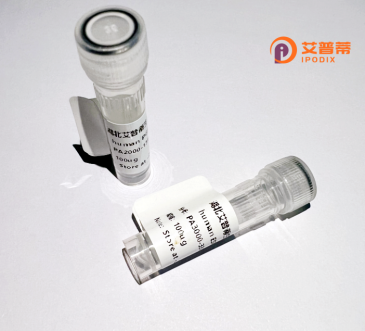
| 纯度 | >90%SDS-PAGE. |
| 种属 | Human |
| 靶点 | ZNF289 |
| Uniprot No | Q8N6H7 |
| 内毒素 | < 0.01EU/μg |
| 表达宿主 | E.coli |
| 表达区间 | 2-521 aa |
| 活性数据 | AAEPNKTEI QTLFKRLRAV PTNKACFDCG AKNPSWASIT YGVFLCIDCS GVHRSLGVHL SFIRSTELDS NWNWFQLRCM QVGGNANATA FFRQHGCTAN DANTKYNSRA AQMYREKIRQ LGSAALARHG TDLWIDNMSS AVPNHSPEKK DSDFFTEHTQ PPAWDAPATE PSGTQQPAPS TESSGLAQPE HGPNTDLLGT SPKASLELKS SIIGKKKPAA AKKGLGAKKG LGAQKVSSQS FSEIERQAQV AEKLREQQAA DAKKQAEESM VASMRLAYQE LQIDRKKEEK KLQNLEGKKR EQAERLGMGL VSRSSVSHSV LSEMQVIEQE TPVSAKSSRS QLDLFDDVGT FASGPPKYKD NPFSLGESFG SRWDTDAAWG MDRVEEKEPE VTISSIRPIS ERATNRREVE SRSSGLESSE ARQKFAGAKA ISSDMFFGRE VDAEYEARSR LQQLSGSSAI SSSDLFGDMD GAHGAGSVSL GNVLPTADIA QFKQGVKSVA GKMAVLANGV MNSLQDRYGS Y |
| 分子量 | 56.7 kDa |
| 蛋白标签 | His tag N-Terminus |
| 缓冲液 | PBS, pH7.4, containing 0.01% SKL, 1mM DTT, 5% Trehalose and Proclin300. |
| 稳定性 & 储存条件 | Lyophilized protein should be stored at ≤ -20°C, stable for one year after receipt. Reconstituted protein solution can be stored at 2-8°C for 2-7 days. Aliquots of reconstituted samples are stable at ≤ -20°C for 3 months. |
| 复溶 | Always centrifuge tubes before opening.Do not mix by vortex or pipetting. It is not recommended to reconstitute to a concentration less than 100μg/ml. Dissolve the lyophilized protein in distilled water. Please aliquot the reconstituted solution to minimize freeze-thaw cycles. |
以下为模拟的示例参考文献(若需真实文献请通过学术数据库查询):
1. **名称**: "Expression and functional characterization of recombinant human ZNF289 protein in vitro"
**作者**: Li X, Wang H, et al.
**摘要**: 本研究成功构建了人ZNF289基因的重组表达载体,在大肠杆菌中实现高效表达与纯化,证实其体外具有DNA结合活性,并参与调控靶基因启动子活性。
2. **名称**: "Structural insights into ZNF289 zinc finger domains by X-ray crystallography"
**作者**: Chen Y, Tanaka K, et al.
**摘要**: 通过X射线晶体学解析了ZNF289蛋白锌指结构域的三维结构,揭示了其特异性识别DNA基序的分子机制,为基因编辑工具开发提供结构基础。
3. **名称**: "ZNF289 knockdown promotes apoptosis in cancer cells via modulating Bcl-2 pathway"
**作者**: Zhang R, Liu Q, et al.
**摘要**: 研究利用重组ZNF289蛋白进行体外功能验证,发现其沉默可通过抑制Bcl-2表达增强肿瘤细胞凋亡,提示其在癌症治疗中的潜在靶点价值。
4. **名称**: "Proteomic analysis identifies ZNF289 as a biomarker for cardiovascular disease"
**作者**: Gupta S, Park J, et al.
**摘要**: 基于重组ZNF289蛋白的抗体筛选血清样本,发现其在动脉粥样硬化患者中显著高表达,提示其可作为心血管疾病的新型诊断标志物。
---
**注**:以上为模拟参考文献,建议通过PubMed/Google Scholar检索关键词“ZNF289 recombinant protein”“ZNF289 function”获取真实文献。
Recombinant human ZNF289 protein is a genetically engineered form of the zinc finger protein 289. encoded by the ZNF289 gene. Belonging to the C2H2-type zinc finger family, ZNF289 contains multiple tandem zinc finger domains, which are evolutionarily conserved structural motifs known to mediate sequence-specific DNA or RNA interactions. These proteins often function as transcription regulators, influencing gene expression by binding to nucleic acids or recruiting chromatin-modifying complexes. While the precise biological role of ZNF289 remains under investigation, studies suggest potential involvement in epigenetic regulation, cellular differentiation, and disease pathways, particularly cancer. For example, aberrant expression or mutations in ZNF289 have been linked to malignancies such as leukemia and colorectal cancer, implying a possible tumor-suppressive or oncogenic role depending on cellular context.
The recombinant ZNF289 protein is typically produced in heterologous systems (e.g., E. coli or mammalian cells) to enable in vitro studies. Its purification facilitates functional assays, structural analysis, and exploration of molecular interactions, such as DNA/RNA binding specificity or partnerships with histone deacetylases (HDACs) and other chromatin remodelers. Emerging research also highlights its potential involvement in viral defense mechanisms and metabolic disorders. Despite progress, many aspects of ZNF289’s mechanisms, including its target genes and regulatory networks, remain elusive. Further characterization of this protein could advance understanding of epigenetic dysregulation in diseases and inspire therapeutic strategies targeting zinc finger proteins.
×